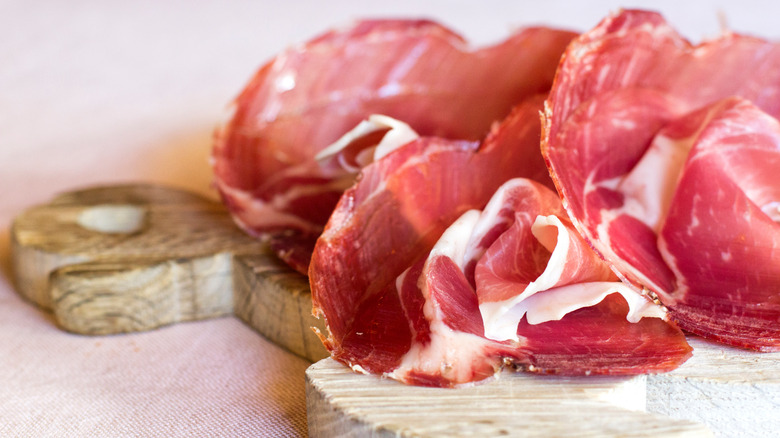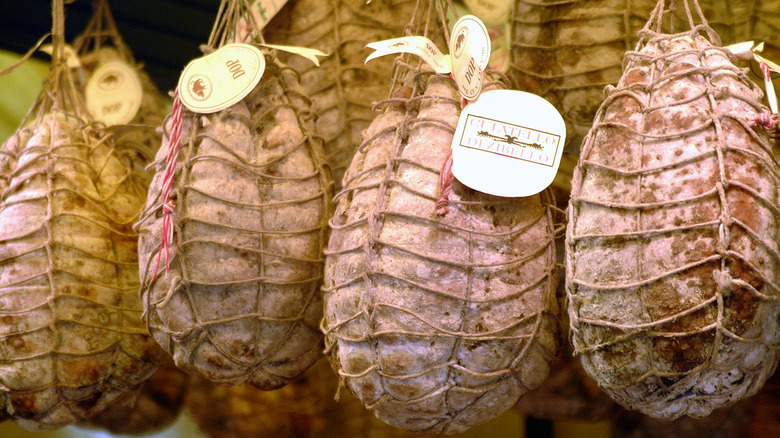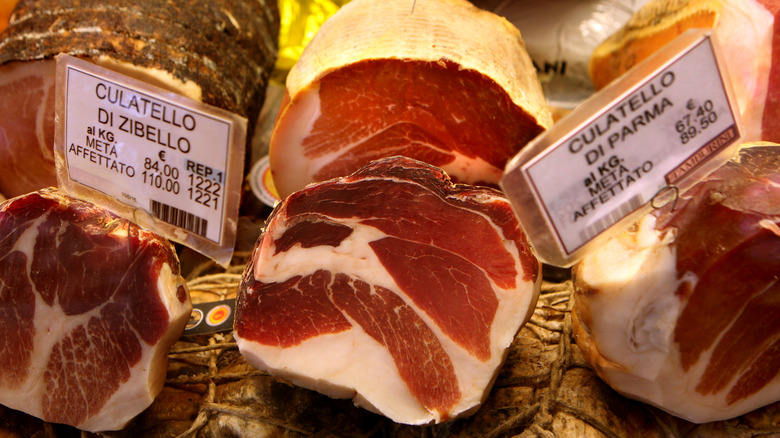Culatello: The Rare Salumi Made The Same Way Since The Middle Ages
Salumi is not a typo of salami. However, salami is indeed a type of salumi, according to SFGATE. Similar to French charcuterie, the Italian salumi refers to meats (usually pork, sometimes beef, lamb, etc.) that have been preserved in the style of Italy's culinary traditions. This includes confit, cooked sausage, fermented meats, pates, salt-cured meats, and smoked ones. Specific types of salumi number in the hundreds, including salami, as just one example.
While "salumi" is not often uttered in many countries besides Italy, that doesn't mean this culinary tradition is anything new. Per the Italian Trade Agency, salumi dates back to Ancient Rome, and during the Renaissance, it was enjoyed at lavish banquets. Later, circa the 1900s, artisanal butcheries were largely replaced by industrial productions. So now, cotechino, mortadella, prosciutto, speck, zampone, and more can be enjoyed all over the world, even if folks eating the meats can't name the category they belong to.
The culinary nature of culatello
One lesser-known example of salumi is culatello. This obscure food is meat that's cut from the thigh muscle of a pig, as Food & Wine explains. More specifically, though, it's the choicest part of that cut, running from the inner leg to the rump, which is why culatello literally translates to "little ass." Appetizing, right?
Well, it turns out, culatello really is quite mouthwatering. Black pepper, garlic, and salt are rubbed into the meat from the beginning. Then, after drying, things take a turn for the slightly unappetizing again; the cut is wrapped in pig bladder and hung in a humid cellar for months on end while developing a coat of mold. However, per the DOP Italian Food Agency, delicious butter and olive oil are also added to aid in the preservation process. This all results in a layered earthy-and-briny taste as well as a melt-in-your-mouth, velvety texture. Plus, the older culatello gets, the softer it becomes, Saveur observes, further accentuating the sweet funkiness of the meat.
This fat-streaked protein is often enjoyed with other salumi as a thinly sliced appetizer placed upon buttered toast or alongside lard-fried gnocco fritto Italian bread, notes La Cucina Italiana. It also pairs quite well with dry sparkling wines. However, the tender culatello is rather delicate and spoils easily, so any leftovers should be properly stored in a cool spot with a dampened cloth and string-wrapped wax paper.
It's a medieval tradition
Just like the history of waffles, culatello's history dates back to the Middle Ages. Per the DOP Italian Food Agency, culatello is said to have originated in rural Italy and made its first public appearance back in 1332 as a wedding gift at the nuptials of two prominent Italians. Yet, it wasn't technically enshrined in written record until 1732, when the Parma Town Council made note of it. Later that same century, even poets discussed the merits of culatello, with one claiming it was heavenly. It's also thought that loyal subjects of the time would gift culatello to Lords as a sort of noble pledge. More impressively, as Saveur mentions, culatello is still made the same way it was all those centuries ago.
True culatello specifically comes from pigs of the Emilia-Romagna and Lombardy regions of Italy. Then, it must be prepared in the country's Parma Province, as close to the foggy Po River as possible. As such, there are only about two dozen producers of authentic culatello in existence, some with moldy basements dating back to the 1300s. This intense regionality along with culatello's perishability means that it isn't too widespread and is rather expensive (via La Cucina Italiana). Still, public figures like George Clooney and King Charles are known to enjoy it, per Food & Wine, and vendors like Amazon and Eataly sell it. You can also find regional approximations of culatello abroad. Many would argue culatello deserves that highest form of flattery.


